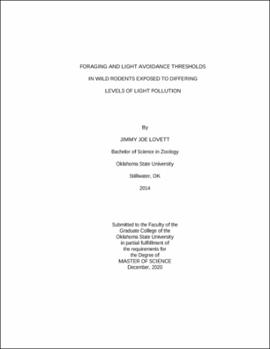| dc.description.abstract | I investigated whether light pollution alters foraging and light avoidance behavior in mice. I hypothesized that: 1.) exposure to light pollution would alter the natural shift in foraging behavior as illumination from the moon increases and 2.) light avoidance sensitivity is dependent on exposure to natural and artificial lighting in the environment. I conducted the study at four sites near Stillwater, Oklahoma that experience differing levels of light pollution. I measured nightly giving-up density in rodents from 16 foraging patches at each study site. I used linear regression models to find effects of light pollution on giving-up densities across a moon cycle. I used a Y-maze behavioral assay to estimate the mean light avoidance threshold in Peromyscus leucopus using the simple up-down method and compare them across all four sites using ANOVA. I found that mean GUDs grouped by light pollution level (low or high) when data were analyzed separately by year (2017: F(1, 40) = 51.97, p < 0.001; 2018: F(1, 35) = 23.62, p < 0.001; 2019: F(1, 34) = 4.727, p = 0.04) but not when all years were combined (All years combined: F(1,114) = 0.265, p = 0.61). Foraging activity responded to changing illumination from the moon only in 2017 at three sites (CCC - F(1,9) = 14.71, p = 0.004, BG - F(1, 8) = 10.27, p = 0.01 and IB - F(1,9) = 19.44, p = 0.002). The stimulus intensity for reversals in the Y-maze in males was significantly different among sites (ANOVA: F(3, 31) = 11.09, p < 0.001). Post-hoc Tukey analysis revealed stimulus intensity of male reversals was higher at the site with the greatest level of artificial light than at the other sites (p < 0.02 - 0.001). The stimulus intensities in which animals failed to respond to the light stimulus was independent of sex (Chi-squared: X2 = 7.24, p = 0.84) and site (Chi-squared: X2 = 49.20, p = 0.07) but dependent on reproductive status (Chi-squared: X2 = 69.12, p = 0.02) for males (Chi-squared: X2 = 37.17, p = 0.01) but not females (Chi-squared: X2 = 4.62, p = 0.87). | |
